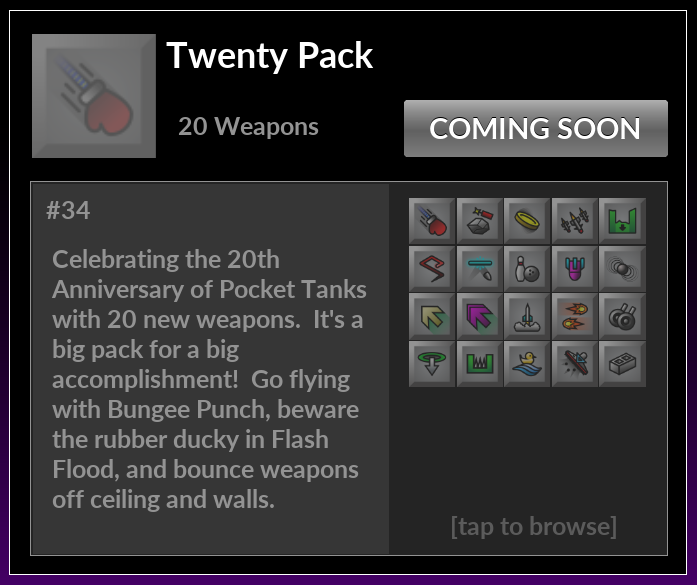We have been hard at work creating a whole bunch of new weapons for Pocket Tanks. What started out as a typical 20 weapon effort turned into a crazy plan to crank out 40 new weapons while we were in the zone! With a grand total of 365 weapons now ready-to-go, 2021 is going to showcase the most ground-breaking weapon packs you have ever seen.
Summer of 2021:
Owners of Pocket Tanks Deluxe will see the release of the “free” Battery Pack (5), and the “for-sale” Neutron Pack (15) this summer.
Rampart:
Construct, climb, and fire from the top of a defensive wall.
Neutron Beam:
An unstoppable beam of neutrons auto-targets opponent.
Fall of 2021:
Coming Soon! To celebrate the 20th Anniversary of Pocket Tanks, we are releasing a “Special Edition” weapon pack that includes 20 weapons that do fun stuff like bounce off the ceiling & walls, rocket your tank around the playfield, and more. Owners of Pocket Tanks Deluxe will see the “for-sale” Twenty Pack (20) arrive later this fall.
Ricochet Rifle:
Zero-gravity sniper round that ricochets all over the place.
Spike Pit:
Digs a deep pit with a surprise at the bottom.
It took well over a year to produce all this new stuff, but as you saw in the release of the Puzzle Pack last year, our new weapon tech lets us create any weapon designs that we can possibly imagine. These 40 weapons represent some of the most advanced tactics and effects ever. And once you see the Flash Flood in action (Twenty Pack), you’ll know why it took so long! In the mid-2000’s we were able to make 20 weapons in about a month. These next-gen weapons take four times longer to create, so we guarantee that you will be pleasantly surprised.
We’ll be spending the rest of 2021 working on a big update to Pocket Tanks that will allow it to run on PC’s and play online games with people on their mobile devices. We have a LOT more planned after that, but that is our next big goal.
Enjoy the new weapons, and we’ll keep on making more! :)
Please visit our Gift Shop and buy some t-shirts, hoodies, and soon we’ll have mugs too. It’s a big encouragement to see those physical orders come in… a real morale boost for our grass-roots indie game efforts.
Thanks for playing!
-Mike
www.blitwise.com


























